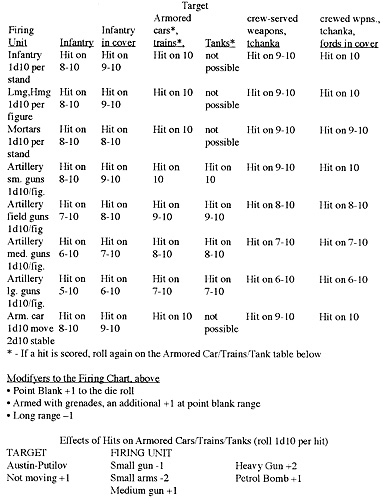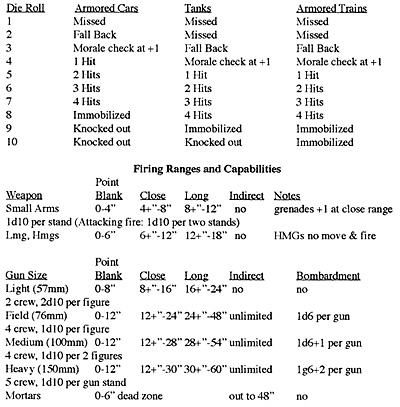These rules were originally written by Craig Martelle in "The Gauntlet" as "Stolichnaya Siding" and they are available on the MagWeb site. They are very easy rules but were improved, modified and upgraded by Jay Stribling. His rules, using 15mm troops, are called Red and White. They are available for free at Jay's "Jackson Gamers Russian Civil War" site. I have modified Jay's version simply because: I use 20mm troops; I did not want to re-base again; and because there were some chrome items I wanted to add. The Russian Civil War gamer can use any of these free sets plus any of the other commercial sets out there and have a pretty good time.
Organization
- Infantry units consist of 8 stands of two men each, 16 total. These can be thought of as a battalion or as a company. Since many battalions in the RCW were of company strength, the difference may be nonexistent.
- Cavalry units are 8 stands of two men each, 16 total. These can be thought of as a Squadron or a regiment. As above, often the terms were synonymous. Dismounted, there will be 6 stands fighting and 2 stands as horse holders.
- Most Machine Guns in this game are heavy, water-cooled guns and are three men per gun. This represents a grouping of 2-4 guns. They may be attached to infantry units or they may form separate companies in units of 3 MG stands plus a two-man command stand, if the game master allows. If attached as an individual stand to an infantry unit, the machine gun stand is not counted for morale purposes as part of the unit.
- A Tchanka is a machine gun w/2-man crew on wagon or cart, always attached to a cavalry unit. Not counted for morale purposes as part of the unit.
- Guns: 1 gun and 4 gunners represent a 2-gun section. A battery is 2 stands plus a 2-man command stand. A section of light guns may be attached to an infantry unit. It moves with the unit, but does not count for morale purposes.
- Tanks and armored cars move as individual units. Each one represents 1 or 2 vehicles.
- Trains represent one train.
Sequence of Action
A complete turn of play is divided into two phases:
RED PHASE
- 1) Move leaders to heroic positions and attempt to activate units.
2) Reds fire any units they wish. White Bombardment is diced for. Effects last until next Red phase.
3) Reds move any units that did not fire.
4) Whites fire defensive fire, including indirect fire/direct fire if not bombarding.**
5) Reds fire units capable of "attacking fire" includes tanks.
6) Resolve melees.
7) Whites test army morale.
WHITE PHASE
- 1) Move leaders to heroic positions and attempt to activate units.
2) Whites fire any units they wish. Red Bombardment is diced for. Effects last until next White phase.
3) Whites move any units that did not fire.
4) Reds fire defensive fire, including indirect fire and direct fire if not bombarding.**
5) Whites fire units capable of "attacking fire" including tanks.
6) Resolve melees.
7) Reds test army morale.
**Units which lost a stand due to fire in phase 2 of that turn are suppressed and may not fire in phase 4 unless they pass a morale test. If they pass morale they may fire 1/2 (round down) of all eligible stands (all MGs fire at full strength).
Unit Activation
Each unit must dice for activation by rolling one d10. The activation number for all units is 3 or more a roll of 1d10 (0=10).
- Modifiers to the activation die roll
Elite unit +1 Cavalry testing in turn after melee Ð2
Heroic leader +1 25% casualties -1
Raw unit -1 50% casualties -2
No leader -1 75% casualties -4
Units which fail to activate are suppressed and may not move or offensively fire in the turn.
Movement
Roll appropriate number of D6. The result is the number of inches moved.
| Unit Type | Clear | Rough | Road |
|---|---|---|---|
| Infantry | 2 | 1 | +1d6 |
| Cavalry | 4 | 2 | +1d6 |
| Tchanka | 4 | 2 | +1d6 |
| Officer | 6 | 6 | +1d6 |
| Tank | 2 | 2 | +2d6 |
| Armored Car,Truck | 2 | n/a | 5 |
| Gun | 3 | 1 | +1d6 |
| Trains | 5 | 5 | 5 |
| Ships | 4 | - | - |
| Wagons | 2 | 1 | +1d6 |
Cavalry +2 D6 if charging
Cavalry may withdraw before melee if they pass a morale check. This is a withdrawal according to orders and the unit is not in fall back status. If the unit fails a morale check, it may still fall back before melee, but is in "fall back" status for the melee (see Melee rules).
Tchanka Same as cavalry but cannot charge.
HMGs,Mortars cannot move AND fire. Take one phase to set-up.
Guns Unlimbered, move 2" (pushed by hand). It takes 1 turn to unlimber and prepare to fire. A gun can limber and move on same turn, but only gets 1/2 movement. Cannot move unlimbered or limbered if it fires.
Ships 3d6 instead if towing barges.
Effects of Bombardment on Movement
In phase two, enemy artillery may attempt to bombard an area. No units except tanks, armored trains, or ships can move through a Bombardment without testing morale. Any morale failure and the unit must stop at edge of bombardment area. If morale test passed, unit's move is cut in half. Tanks and armored trains may move through without testing morale, but do so at half rate. Ships are not affected by bombardment.
Firing
In sub phases 2, 4 and 5, firing may take place. Refer to the chart below for basic 'to hit' numbers.


Fire effects on special target
If a unit is hit, the firing player will roll another D10 for each hit. If a 0 is rolled, the firing player may select a special stand for elimination. For example, a machine gun stand or a Cheka stand or a priest or a heroic leader could be eliminated. Otherwise, all losses come off of the infantry/cavalry first.
Indirect Fire
Forward Observers with either flags or a field telephone/Morse must be attached to a unit if indirect fire is allowed. If said spotter can see the target, there is a 1-7 on a d10 chance that indirect fire can be brought down on the target when Interventionist artillery is firing, but only a 1-3, if Russian gunners are firing. Failure to make the die roll will cancel any artillery fire from that gun (except in self defense at point blank range) for that player's turn.
Bombardment is an area that artillery is firing into, in an attempt to keep enemy units from moving through it or out of it. If a unit is in, or enters into, an area that is being bombarded, it may not move any farther that turn without passing a morale test. If it does not pass morale it is suppressed. (No movement or firing allowed until the unit passes a morale test). No unit may fire through a bombardment area.
Even if it passes morale, a unit may move only half normal move through a bombardment area. If the testing unit rolls an unmodified "9-10" on morale, it takes a one stand casualty due to the bombardment. The number of guns firing into a bombardment area determine if the unit is being bombarded or not. Roll a D6 (modified by gun size) for each section of guns attempting to bombard that area. If the dice total 12 or more, they are is being bombarded. Otherwise, it is intermittent fire with no effect. Add a +1 for each Allied interventionist gun stand.
- Gun Size Bombardment area size
Light guns May not Bombard
Field guns Bombardment area 4" x 4"
Medium guns Bombardment area 4" x 6"
Heavy guns Bombardment area 4" x 8"
Bombardment does not normally inflict casualties but is used mainly to retard movement and impede shooting.
Attacking Fire
Some units may fire after they have moved, and if not suppressed, when attacking into melee.
Claiming Cover
There will be areas on the battlefield designated as cover. A unit inside such cover and not at the edge capable of firing and seeing out is said to be in complete cover. It may not be seen nor fired at unless the umpire sets up special rules. Units at the edge of such cover, but able to fire out and be seen, are referred to as being in cover. Note the difference between cover and complete cover. Being in defilade behind hills or woods usually gives complete cover.
Due to the irregularities of the ground, there will be folds and depressions, that may provide cover but are too subtle to be represented with the usual miniature hills. To attempt to recreate this, any unit that moves only half or less of the movement to which it is entitled by the dice may claim to be in cover. Place a "Cover Marker" or otherwise designate the unit as being in cover. Note that units that claim cover by virtue of taking only half move, may only do so against units which they could see or had knowledge of during their move. Also, units that claim cover by virtue of taking only 1/2 move, may NOT do so against units which are firing on them from Point Blank range.
Back to The Herald 56 Table of Contents
Back to The Herald List of Issues
Back to MagWeb Master Magazine List
© Copyright 2004 by HMGS-GL.
This article appears in MagWeb.com (Magazine Web) on the Internet World Wide Web. Other articles from military history and related magazines are available at http://www.magweb.com